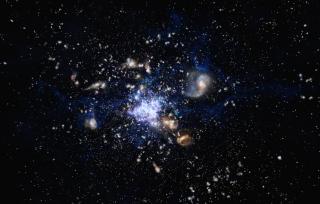Bibcode
Urrutia, T.; Hodge, J.; Dannerbauer, H.; Davis, T. A.; Jahnke, K.; Husemann, B.
Bibliographical reference
Monthly Notices of the Royal Astronomical Society, Volume 470, Issue 2, p.1570-1586
Advertised on:
9
2017
Citations
49
Refereed citations
45
Description
We present single-dish 12CO(1-0) and 12CO(2-1)
observations for 14 low-redshift quasi-stellar objects (QSOs). In
combination with optical integral field spectroscopy, we study how the
cold gas content relates to the star formation rate (SFR) and black hole
accretion rate. 12CO(1-0) is detected in 8 of 14 targets and
12CO(2-1) is detected in 7 out of 11 cases. The majority of
disc-dominated QSOs reveal gas fractions and depletion times matching
normal star-forming systems. Two gas-rich major mergers show clear
starburst signatures with higher than average gas fractions and shorter
depletion times. Bulge-dominated QSO hosts are mainly undetected in
12CO(1-0), which corresponds, on average, to lower gas
fractions than in disc-dominated counterparts. Their SFRs, however,
imply shorter than average depletion times and higher star formation
efficiencies. Negative QSO feedback through removal of cold gas seems to
play a negligible role in our sample. We find a trend between black hole
accretion rate and total molecular gas content for disc-dominated QSOs
when combined with literature samples. We interpret this as an upper
envelope for the nuclear activity and it is well represented by a
scaling relation between the total and circumnuclear gas reservoir
accessible for accretion. Bulge-dominated QSOs significantly differ from
that scaling relation and appear uncorrelated with the total molecular
gas content. This could be explained either by a more compact gas
reservoir, blown out of the gas envelope through outflows, or a
different interstellar medium phase composition.
Related projects

Molecular Gas and Dust in Galaxies Across Cosmic Time
Two of the most fundamental questions in astrophysics are the conversion of molecular gas into stars and how this physical process is a function of environments on all scales, ranging from planetary systems, stellar clusters, galaxies to galaxy clusters. The main goal of this internal project is to get insight into the formation and evolution of
Helmut
Dannerbauer